Tourism Demand and Supply Analysis
VerifiedAdded on 2020/01/28
|13
|2956
|354
Essay
AI Summary
This assignment delves into the concept of supply and demand within the context of the tourism industry. It examines how simultaneous shifts in both demand and supply can impact market equilibrium, referencing various case studies and economic principles. The analysis includes visual representations (graphs) to illustrate these concepts and a stakeholders matrix highlighting key players involved.
Contribute Materials
Your contribution can guide someone’s learning journey. Share your
documents today.
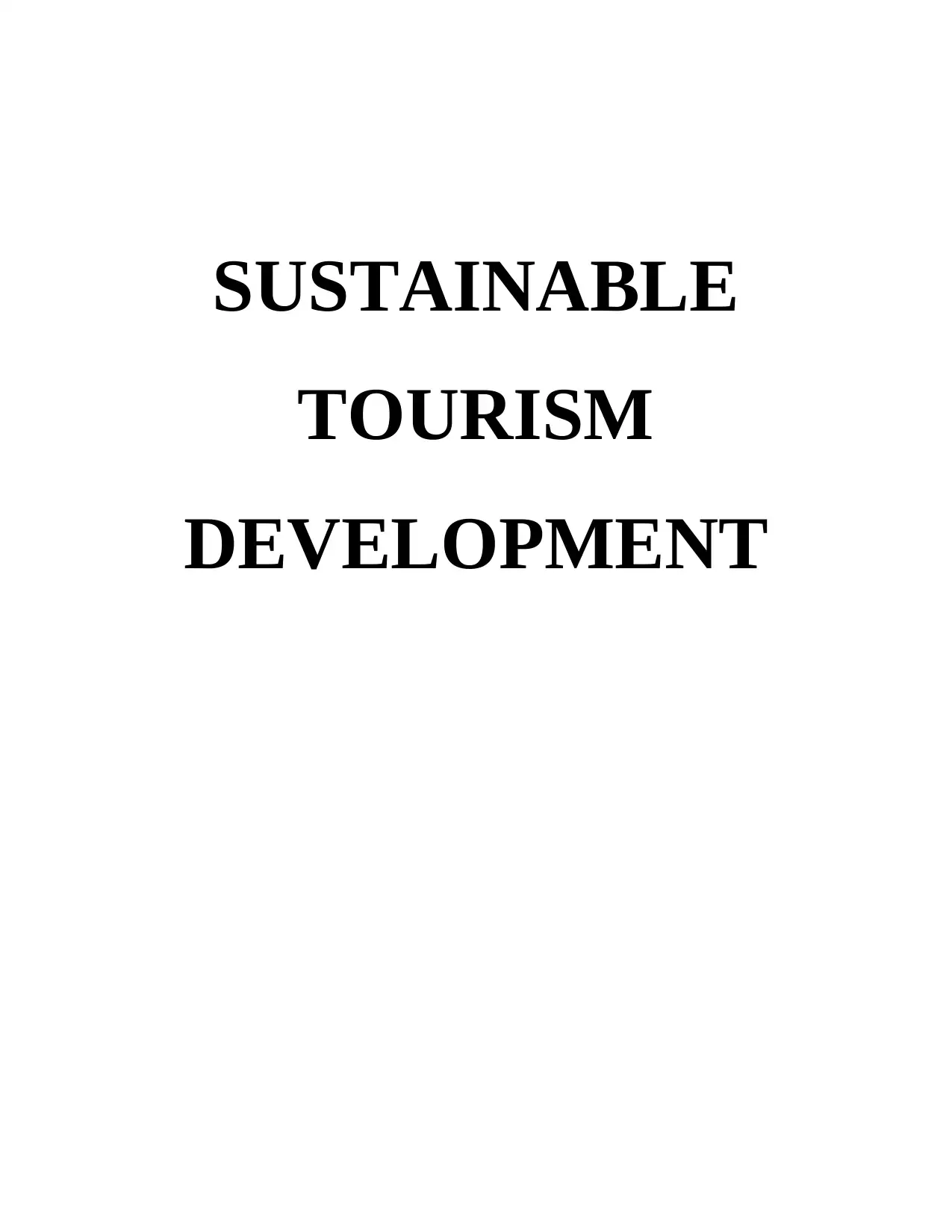
SUSTAINABLE
TOURISM
DEVELOPMENT
TOURISM
DEVELOPMENT
Secure Best Marks with AI Grader
Need help grading? Try our AI Grader for instant feedback on your assignments.
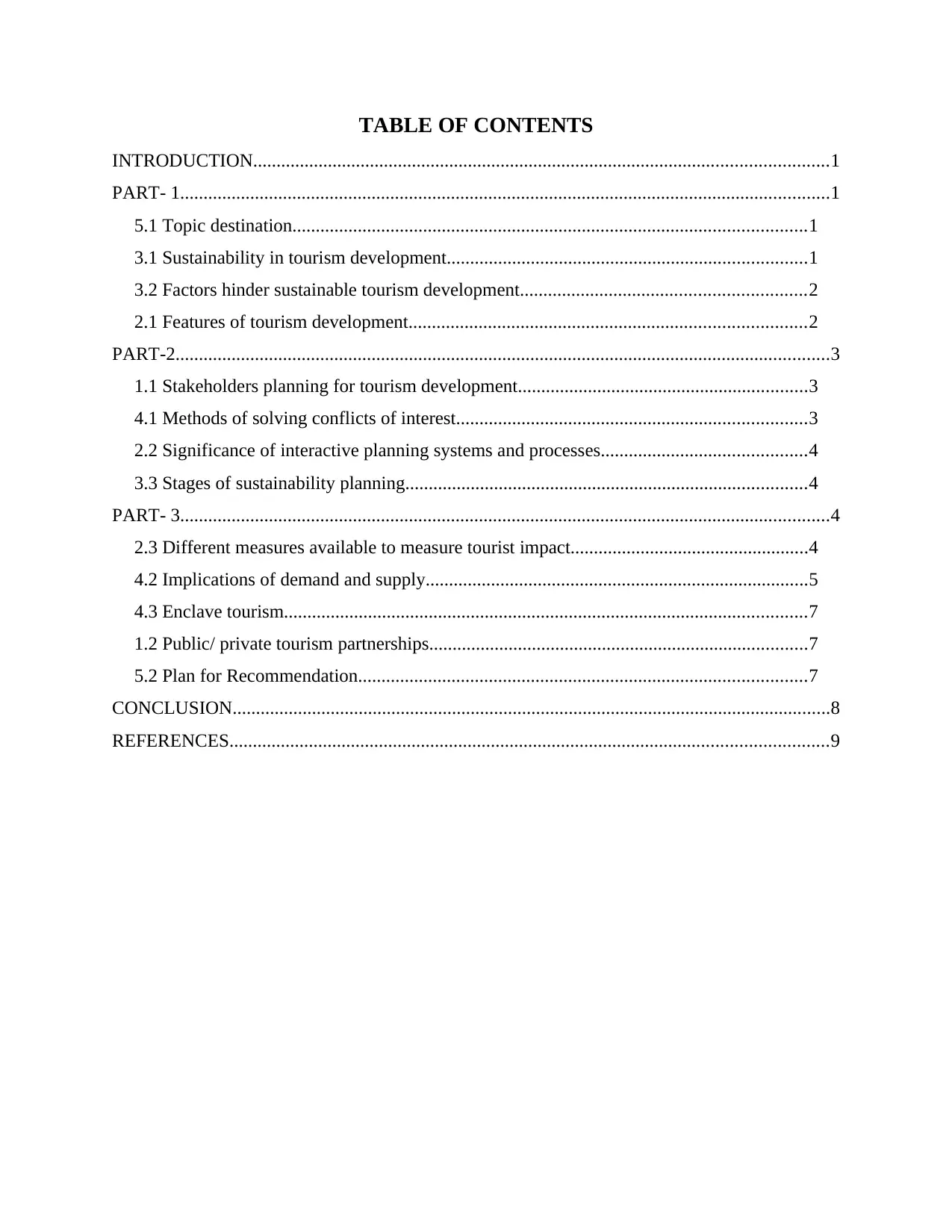
TABLE OF CONTENTS
INTRODUCTION...........................................................................................................................1
PART- 1...........................................................................................................................................1
5.1 Topic destination..............................................................................................................1
3.1 Sustainability in tourism development.............................................................................1
3.2 Factors hinder sustainable tourism development.............................................................2
2.1 Features of tourism development.....................................................................................2
PART-2............................................................................................................................................3
1.1 Stakeholders planning for tourism development..............................................................3
4.1 Methods of solving conflicts of interest...........................................................................3
2.2 Significance of interactive planning systems and processes............................................4
3.3 Stages of sustainability planning......................................................................................4
PART- 3...........................................................................................................................................4
2.3 Different measures available to measure tourist impact...................................................4
4.2 Implications of demand and supply..................................................................................5
4.3 Enclave tourism................................................................................................................7
1.2 Public/ private tourism partnerships.................................................................................7
5.2 Plan for Recommendation................................................................................................7
CONCLUSION................................................................................................................................8
REFERENCES................................................................................................................................9
INTRODUCTION...........................................................................................................................1
PART- 1...........................................................................................................................................1
5.1 Topic destination..............................................................................................................1
3.1 Sustainability in tourism development.............................................................................1
3.2 Factors hinder sustainable tourism development.............................................................2
2.1 Features of tourism development.....................................................................................2
PART-2............................................................................................................................................3
1.1 Stakeholders planning for tourism development..............................................................3
4.1 Methods of solving conflicts of interest...........................................................................3
2.2 Significance of interactive planning systems and processes............................................4
3.3 Stages of sustainability planning......................................................................................4
PART- 3...........................................................................................................................................4
2.3 Different measures available to measure tourist impact...................................................4
4.2 Implications of demand and supply..................................................................................5
4.3 Enclave tourism................................................................................................................7
1.2 Public/ private tourism partnerships.................................................................................7
5.2 Plan for Recommendation................................................................................................7
CONCLUSION................................................................................................................................8
REFERENCES................................................................................................................................9

ILLUSTRATION INDEX
Illustration 1: Equilibrium situation for demand and supply...........................................................5
Illustration 2: Increase in Demand and Decrease in Supply Graph.................................................6
Illustration 3: Decrease in demand and decrease in Supply Graph.................................................6
Illustration 1: Equilibrium situation for demand and supply...........................................................5
Illustration 2: Increase in Demand and Decrease in Supply Graph.................................................6
Illustration 3: Decrease in demand and decrease in Supply Graph.................................................6
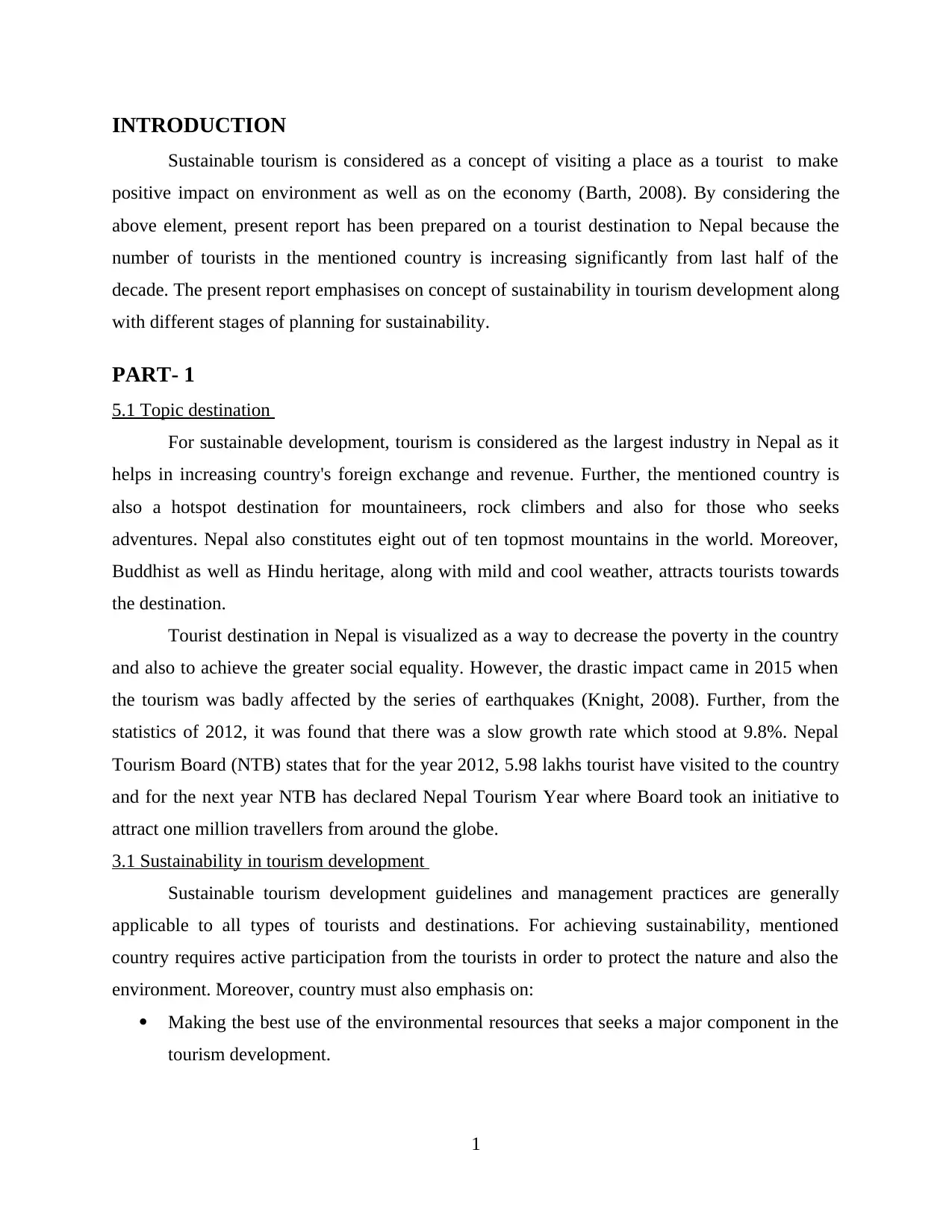
INTRODUCTION
Sustainable tourism is considered as a concept of visiting a place as a tourist to make
positive impact on environment as well as on the economy (Barth, 2008). By considering the
above element, present report has been prepared on a tourist destination to Nepal because the
number of tourists in the mentioned country is increasing significantly from last half of the
decade. The present report emphasises on concept of sustainability in tourism development along
with different stages of planning for sustainability.
PART- 1
5.1 Topic destination
For sustainable development, tourism is considered as the largest industry in Nepal as it
helps in increasing country's foreign exchange and revenue. Further, the mentioned country is
also a hotspot destination for mountaineers, rock climbers and also for those who seeks
adventures. Nepal also constitutes eight out of ten topmost mountains in the world. Moreover,
Buddhist as well as Hindu heritage, along with mild and cool weather, attracts tourists towards
the destination.
Tourist destination in Nepal is visualized as a way to decrease the poverty in the country
and also to achieve the greater social equality. However, the drastic impact came in 2015 when
the tourism was badly affected by the series of earthquakes (Knight, 2008). Further, from the
statistics of 2012, it was found that there was a slow growth rate which stood at 9.8%. Nepal
Tourism Board (NTB) states that for the year 2012, 5.98 lakhs tourist have visited to the country
and for the next year NTB has declared Nepal Tourism Year where Board took an initiative to
attract one million travellers from around the globe.
3.1 Sustainability in tourism development
Sustainable tourism development guidelines and management practices are generally
applicable to all types of tourists and destinations. For achieving sustainability, mentioned
country requires active participation from the tourists in order to protect the nature and also the
environment. Moreover, country must also emphasis on:
Making the best use of the environmental resources that seeks a major component in the
tourism development.
1
Sustainable tourism is considered as a concept of visiting a place as a tourist to make
positive impact on environment as well as on the economy (Barth, 2008). By considering the
above element, present report has been prepared on a tourist destination to Nepal because the
number of tourists in the mentioned country is increasing significantly from last half of the
decade. The present report emphasises on concept of sustainability in tourism development along
with different stages of planning for sustainability.
PART- 1
5.1 Topic destination
For sustainable development, tourism is considered as the largest industry in Nepal as it
helps in increasing country's foreign exchange and revenue. Further, the mentioned country is
also a hotspot destination for mountaineers, rock climbers and also for those who seeks
adventures. Nepal also constitutes eight out of ten topmost mountains in the world. Moreover,
Buddhist as well as Hindu heritage, along with mild and cool weather, attracts tourists towards
the destination.
Tourist destination in Nepal is visualized as a way to decrease the poverty in the country
and also to achieve the greater social equality. However, the drastic impact came in 2015 when
the tourism was badly affected by the series of earthquakes (Knight, 2008). Further, from the
statistics of 2012, it was found that there was a slow growth rate which stood at 9.8%. Nepal
Tourism Board (NTB) states that for the year 2012, 5.98 lakhs tourist have visited to the country
and for the next year NTB has declared Nepal Tourism Year where Board took an initiative to
attract one million travellers from around the globe.
3.1 Sustainability in tourism development
Sustainable tourism development guidelines and management practices are generally
applicable to all types of tourists and destinations. For achieving sustainability, mentioned
country requires active participation from the tourists in order to protect the nature and also the
environment. Moreover, country must also emphasis on:
Making the best use of the environmental resources that seeks a major component in the
tourism development.
1
Secure Best Marks with AI Grader
Need help grading? Try our AI Grader for instant feedback on your assignments.
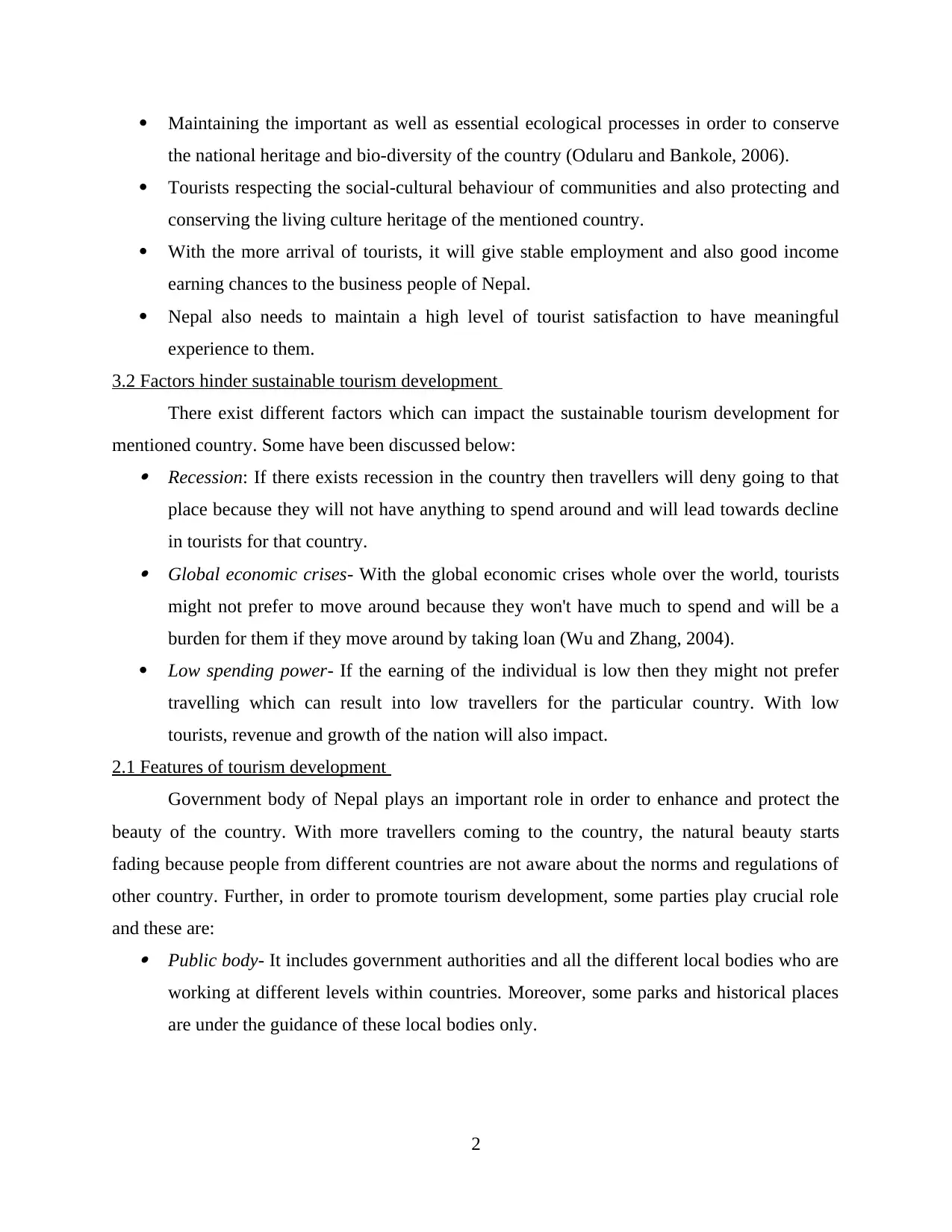
Maintaining the important as well as essential ecological processes in order to conserve
the national heritage and bio-diversity of the country (Odularu and Bankole, 2006).
Tourists respecting the social-cultural behaviour of communities and also protecting and
conserving the living culture heritage of the mentioned country.
With the more arrival of tourists, it will give stable employment and also good income
earning chances to the business people of Nepal.
Nepal also needs to maintain a high level of tourist satisfaction to have meaningful
experience to them.
3.2 Factors hinder sustainable tourism development
There exist different factors which can impact the sustainable tourism development for
mentioned country. Some have been discussed below: Recession: If there exists recession in the country then travellers will deny going to that
place because they will not have anything to spend around and will lead towards decline
in tourists for that country. Global economic crises- With the global economic crises whole over the world, tourists
might not prefer to move around because they won't have much to spend and will be a
burden for them if they move around by taking loan (Wu and Zhang, 2004).
Low spending power- If the earning of the individual is low then they might not prefer
travelling which can result into low travellers for the particular country. With low
tourists, revenue and growth of the nation will also impact.
2.1 Features of tourism development
Government body of Nepal plays an important role in order to enhance and protect the
beauty of the country. With more travellers coming to the country, the natural beauty starts
fading because people from different countries are not aware about the norms and regulations of
other country. Further, in order to promote tourism development, some parties play crucial role
and these are: Public body- It includes government authorities and all the different local bodies who are
working at different levels within countries. Moreover, some parks and historical places
are under the guidance of these local bodies only.
2
the national heritage and bio-diversity of the country (Odularu and Bankole, 2006).
Tourists respecting the social-cultural behaviour of communities and also protecting and
conserving the living culture heritage of the mentioned country.
With the more arrival of tourists, it will give stable employment and also good income
earning chances to the business people of Nepal.
Nepal also needs to maintain a high level of tourist satisfaction to have meaningful
experience to them.
3.2 Factors hinder sustainable tourism development
There exist different factors which can impact the sustainable tourism development for
mentioned country. Some have been discussed below: Recession: If there exists recession in the country then travellers will deny going to that
place because they will not have anything to spend around and will lead towards decline
in tourists for that country. Global economic crises- With the global economic crises whole over the world, tourists
might not prefer to move around because they won't have much to spend and will be a
burden for them if they move around by taking loan (Wu and Zhang, 2004).
Low spending power- If the earning of the individual is low then they might not prefer
travelling which can result into low travellers for the particular country. With low
tourists, revenue and growth of the nation will also impact.
2.1 Features of tourism development
Government body of Nepal plays an important role in order to enhance and protect the
beauty of the country. With more travellers coming to the country, the natural beauty starts
fading because people from different countries are not aware about the norms and regulations of
other country. Further, in order to promote tourism development, some parties play crucial role
and these are: Public body- It includes government authorities and all the different local bodies who are
working at different levels within countries. Moreover, some parks and historical places
are under the guidance of these local bodies only.
2
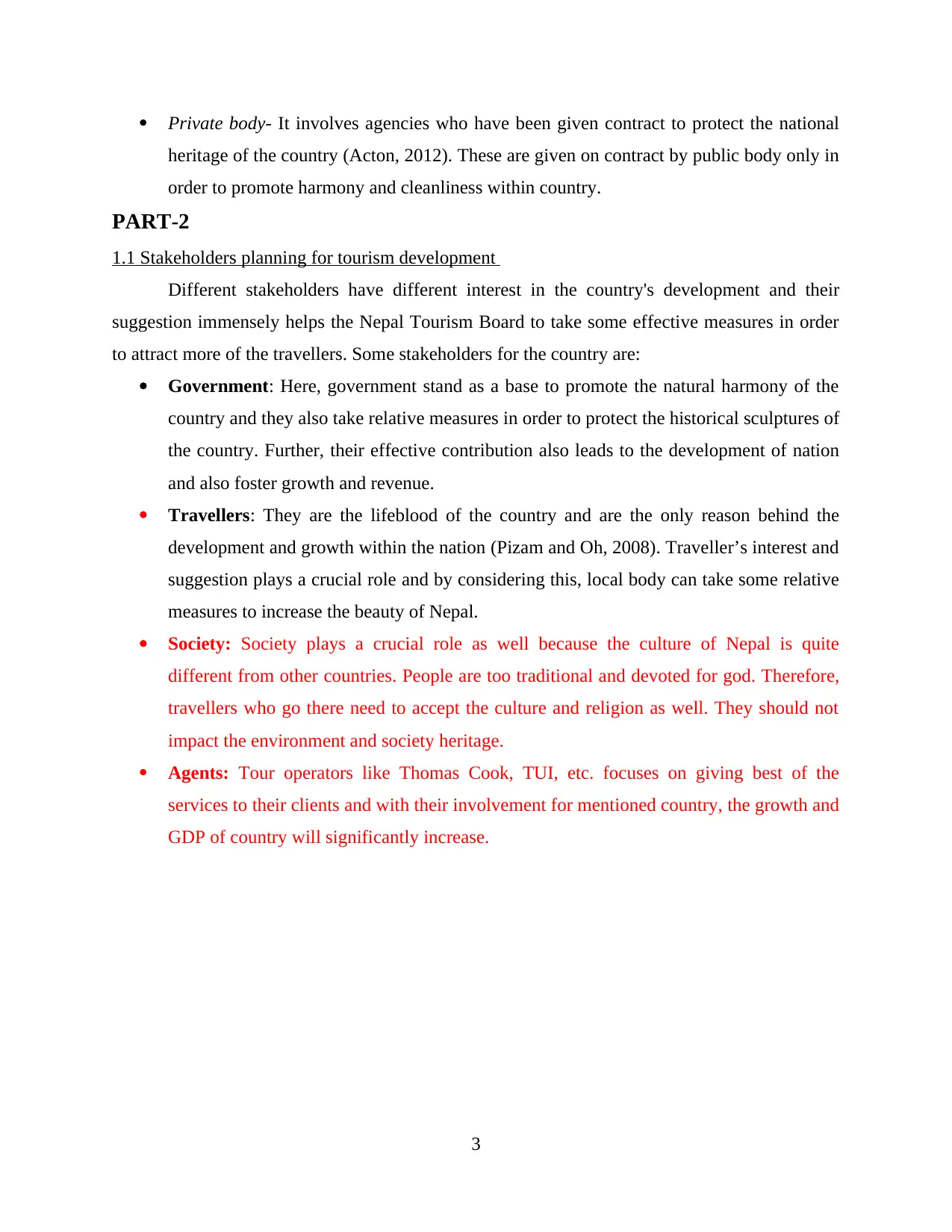
Private body- It involves agencies who have been given contract to protect the national
heritage of the country (Acton, 2012). These are given on contract by public body only in
order to promote harmony and cleanliness within country.
PART-2
1.1 Stakeholders planning for tourism development
Different stakeholders have different interest in the country's development and their
suggestion immensely helps the Nepal Tourism Board to take some effective measures in order
to attract more of the travellers. Some stakeholders for the country are:
Government: Here, government stand as a base to promote the natural harmony of the
country and they also take relative measures in order to protect the historical sculptures of
the country. Further, their effective contribution also leads to the development of nation
and also foster growth and revenue.
Travellers: They are the lifeblood of the country and are the only reason behind the
development and growth within the nation (Pizam and Oh, 2008). Traveller’s interest and
suggestion plays a crucial role and by considering this, local body can take some relative
measures to increase the beauty of Nepal.
Society: Society plays a crucial role as well because the culture of Nepal is quite
different from other countries. People are too traditional and devoted for god. Therefore,
travellers who go there need to accept the culture and religion as well. They should not
impact the environment and society heritage.
Agents: Tour operators like Thomas Cook, TUI, etc. focuses on giving best of the
services to their clients and with their involvement for mentioned country, the growth and
GDP of country will significantly increase.
3
heritage of the country (Acton, 2012). These are given on contract by public body only in
order to promote harmony and cleanliness within country.
PART-2
1.1 Stakeholders planning for tourism development
Different stakeholders have different interest in the country's development and their
suggestion immensely helps the Nepal Tourism Board to take some effective measures in order
to attract more of the travellers. Some stakeholders for the country are:
Government: Here, government stand as a base to promote the natural harmony of the
country and they also take relative measures in order to protect the historical sculptures of
the country. Further, their effective contribution also leads to the development of nation
and also foster growth and revenue.
Travellers: They are the lifeblood of the country and are the only reason behind the
development and growth within the nation (Pizam and Oh, 2008). Traveller’s interest and
suggestion plays a crucial role and by considering this, local body can take some relative
measures to increase the beauty of Nepal.
Society: Society plays a crucial role as well because the culture of Nepal is quite
different from other countries. People are too traditional and devoted for god. Therefore,
travellers who go there need to accept the culture and religion as well. They should not
impact the environment and society heritage.
Agents: Tour operators like Thomas Cook, TUI, etc. focuses on giving best of the
services to their clients and with their involvement for mentioned country, the growth and
GDP of country will significantly increase.
3

Illustration 1: Stakeholders Matrix
4.1 Methods of solving conflicts of interest
Nepal is a beautiful nation which consists of different historical, religious sites, natural
scenes and different social culture. However, a country face some major problems has and onw
among them enable the reduction in number of travellers to visit Nepal. Country has inadequate
or less infrastructural development which generally distracts the mind of travellers to visit such
place. In order to meet this, local body have to take some crucial steps as well.
Further, mentioned country also have less means of entertainment and these sources are
not been properly managed as well. Government body have to take some prior steps in order to
promote the country's growth and revenue. Moreover, Nepal does not even have proper tourism
centres as well and this is the only reason that travellers are unable to acquire adequate
information to reach to the mentioned country (Santana, 2000). In order to meet this, government
can focus on setting up the tourist centres.
2.2 Significance of interactive planning systems and processes
Interactive planning system includes stakeholders in order to have their meaningful
contribution in the nation’s growth and development. All the policies and major decisions for the
country's development are taken by the government. These local bodies also ask for the
necessary changes or needs from the travellers and business organizations. With their
4
4.1 Methods of solving conflicts of interest
Nepal is a beautiful nation which consists of different historical, religious sites, natural
scenes and different social culture. However, a country face some major problems has and onw
among them enable the reduction in number of travellers to visit Nepal. Country has inadequate
or less infrastructural development which generally distracts the mind of travellers to visit such
place. In order to meet this, local body have to take some crucial steps as well.
Further, mentioned country also have less means of entertainment and these sources are
not been properly managed as well. Government body have to take some prior steps in order to
promote the country's growth and revenue. Moreover, Nepal does not even have proper tourism
centres as well and this is the only reason that travellers are unable to acquire adequate
information to reach to the mentioned country (Santana, 2000). In order to meet this, government
can focus on setting up the tourist centres.
2.2 Significance of interactive planning systems and processes
Interactive planning system includes stakeholders in order to have their meaningful
contribution in the nation’s growth and development. All the policies and major decisions for the
country's development are taken by the government. These local bodies also ask for the
necessary changes or needs from the travellers and business organizations. With their
4
Paraphrase This Document
Need a fresh take? Get an instant paraphrase of this document with our AI Paraphraser
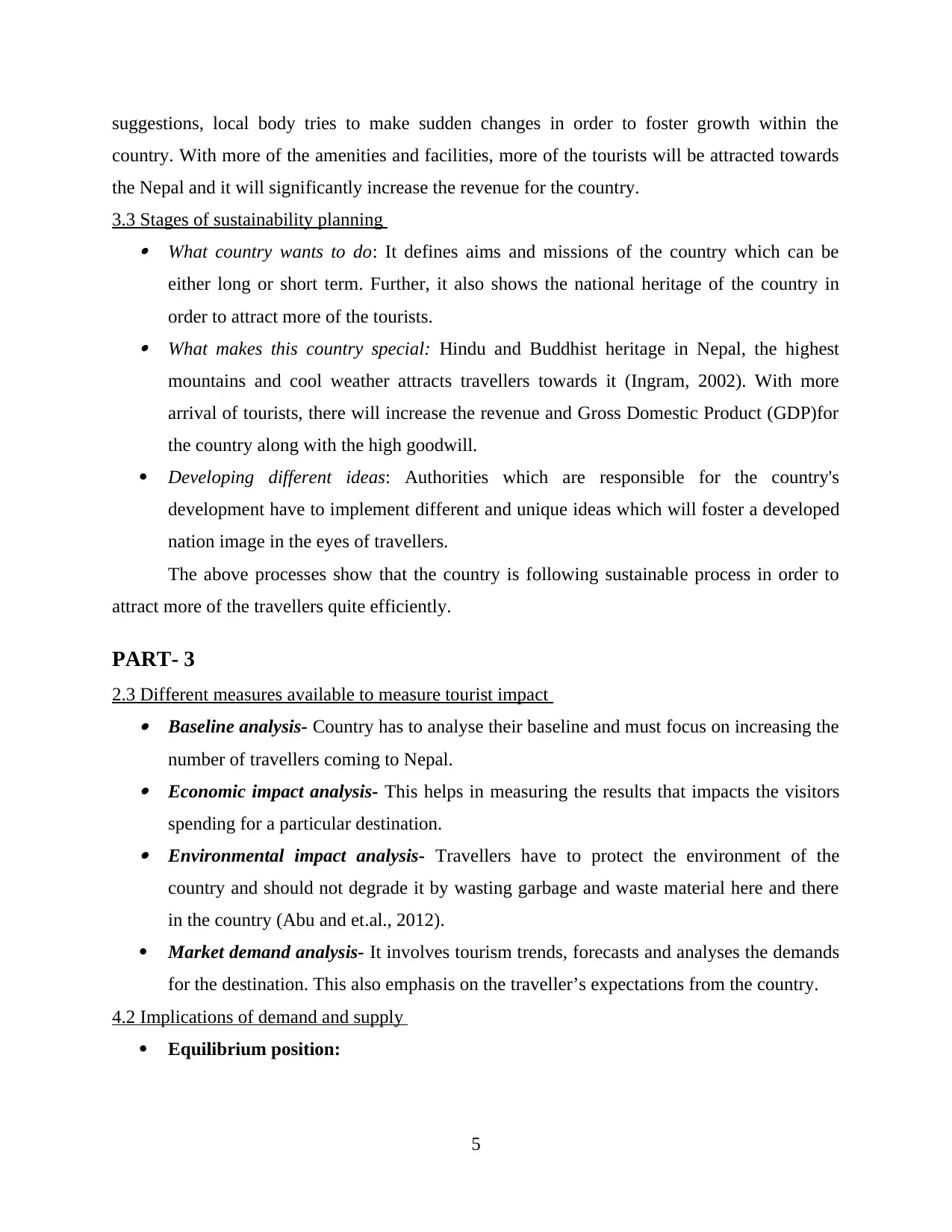
suggestions, local body tries to make sudden changes in order to foster growth within the
country. With more of the amenities and facilities, more of the tourists will be attracted towards
the Nepal and it will significantly increase the revenue for the country.
3.3 Stages of sustainability planning What country wants to do: It defines aims and missions of the country which can be
either long or short term. Further, it also shows the national heritage of the country in
order to attract more of the tourists. What makes this country special: Hindu and Buddhist heritage in Nepal, the highest
mountains and cool weather attracts travellers towards it (Ingram, 2002). With more
arrival of tourists, there will increase the revenue and Gross Domestic Product (GDP)for
the country along with the high goodwill.
Developing different ideas: Authorities which are responsible for the country's
development have to implement different and unique ideas which will foster a developed
nation image in the eyes of travellers.
The above processes show that the country is following sustainable process in order to
attract more of the travellers quite efficiently.
PART- 3
2.3 Different measures available to measure tourist impact Baseline analysis- Country has to analyse their baseline and must focus on increasing the
number of travellers coming to Nepal. Economic impact analysis- This helps in measuring the results that impacts the visitors
spending for a particular destination. Environmental impact analysis- Travellers have to protect the environment of the
country and should not degrade it by wasting garbage and waste material here and there
in the country (Abu and et.al., 2012).
Market demand analysis- It involves tourism trends, forecasts and analyses the demands
for the destination. This also emphasis on the traveller’s expectations from the country.
4.2 Implications of demand and supply
Equilibrium position:
5
country. With more of the amenities and facilities, more of the tourists will be attracted towards
the Nepal and it will significantly increase the revenue for the country.
3.3 Stages of sustainability planning What country wants to do: It defines aims and missions of the country which can be
either long or short term. Further, it also shows the national heritage of the country in
order to attract more of the tourists. What makes this country special: Hindu and Buddhist heritage in Nepal, the highest
mountains and cool weather attracts travellers towards it (Ingram, 2002). With more
arrival of tourists, there will increase the revenue and Gross Domestic Product (GDP)for
the country along with the high goodwill.
Developing different ideas: Authorities which are responsible for the country's
development have to implement different and unique ideas which will foster a developed
nation image in the eyes of travellers.
The above processes show that the country is following sustainable process in order to
attract more of the travellers quite efficiently.
PART- 3
2.3 Different measures available to measure tourist impact Baseline analysis- Country has to analyse their baseline and must focus on increasing the
number of travellers coming to Nepal. Economic impact analysis- This helps in measuring the results that impacts the visitors
spending for a particular destination. Environmental impact analysis- Travellers have to protect the environment of the
country and should not degrade it by wasting garbage and waste material here and there
in the country (Abu and et.al., 2012).
Market demand analysis- It involves tourism trends, forecasts and analyses the demands
for the destination. This also emphasis on the traveller’s expectations from the country.
4.2 Implications of demand and supply
Equilibrium position:
5
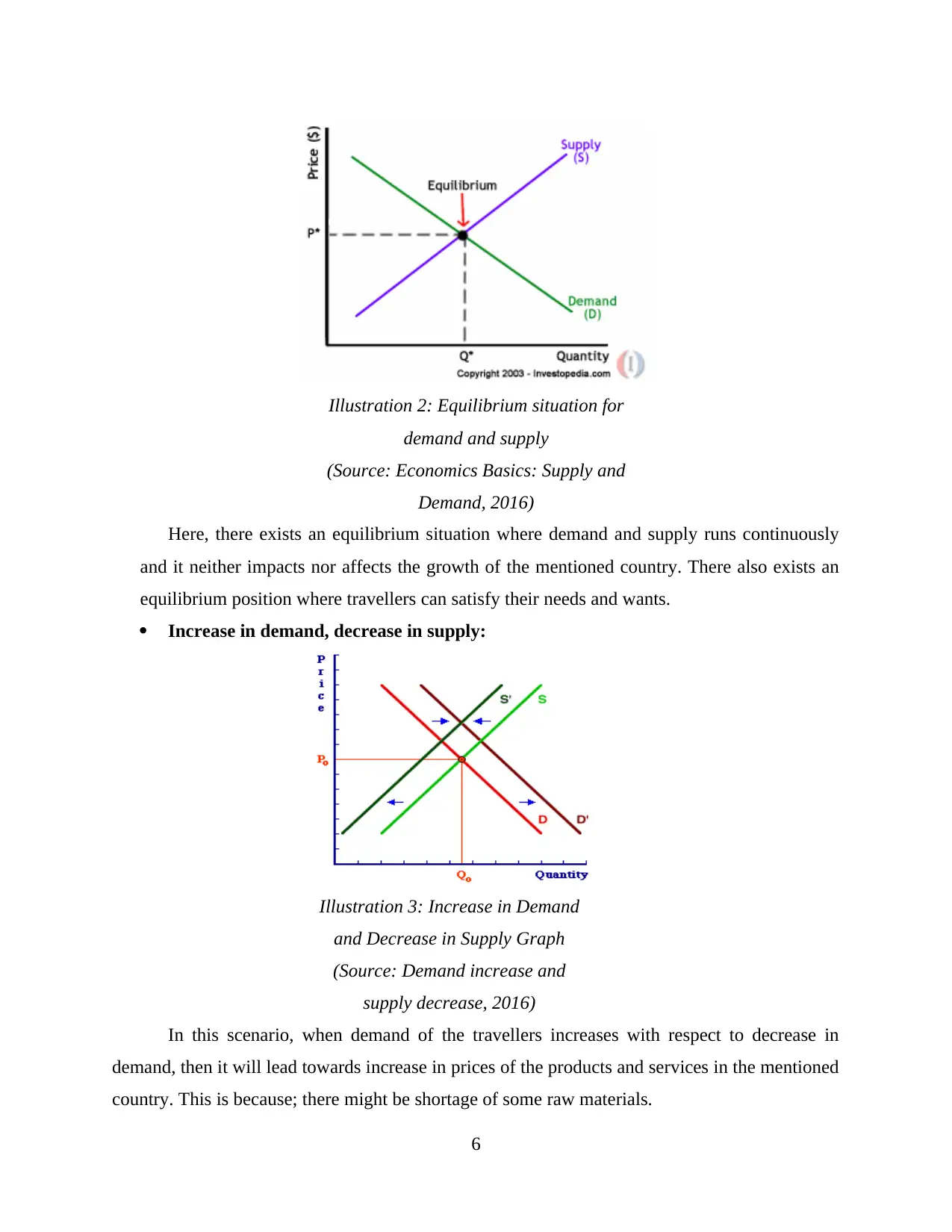
Here, there exists an equilibrium situation where demand and supply runs continuously
and it neither impacts nor affects the growth of the mentioned country. There also exists an
equilibrium position where travellers can satisfy their needs and wants.
Increase in demand, decrease in supply:
Illustration 3: Increase in Demand
and Decrease in Supply Graph
(Source: Demand increase and
supply decrease, 2016)
In this scenario, when demand of the travellers increases with respect to decrease in
demand, then it will lead towards increase in prices of the products and services in the mentioned
country. This is because; there might be shortage of some raw materials.
6
Illustration 2: Equilibrium situation for
demand and supply
(Source: Economics Basics: Supply and
Demand, 2016)
and it neither impacts nor affects the growth of the mentioned country. There also exists an
equilibrium position where travellers can satisfy their needs and wants.
Increase in demand, decrease in supply:
Illustration 3: Increase in Demand
and Decrease in Supply Graph
(Source: Demand increase and
supply decrease, 2016)
In this scenario, when demand of the travellers increases with respect to decrease in
demand, then it will lead towards increase in prices of the products and services in the mentioned
country. This is because; there might be shortage of some raw materials.
6
Illustration 2: Equilibrium situation for
demand and supply
(Source: Economics Basics: Supply and
Demand, 2016)
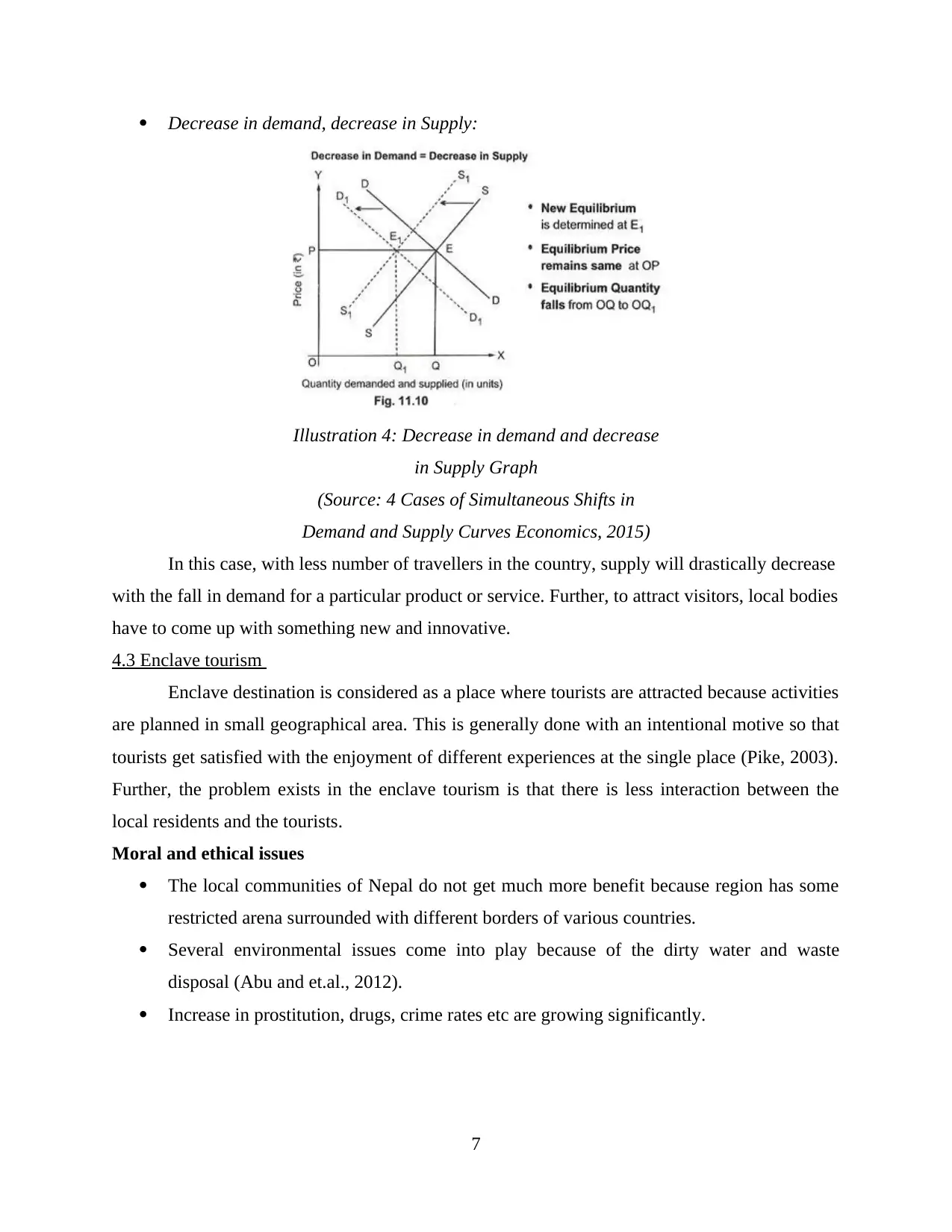
Decrease in demand, decrease in Supply:
Illustration 4: Decrease in demand and decrease
in Supply Graph
(Source: 4 Cases of Simultaneous Shifts in
Demand and Supply Curves Economics, 2015)
In this case, with less number of travellers in the country, supply will drastically decrease
with the fall in demand for a particular product or service. Further, to attract visitors, local bodies
have to come up with something new and innovative.
4.3 Enclave tourism
Enclave destination is considered as a place where tourists are attracted because activities
are planned in small geographical area. This is generally done with an intentional motive so that
tourists get satisfied with the enjoyment of different experiences at the single place (Pike, 2003).
Further, the problem exists in the enclave tourism is that there is less interaction between the
local residents and the tourists.
Moral and ethical issues
The local communities of Nepal do not get much more benefit because region has some
restricted arena surrounded with different borders of various countries.
Several environmental issues come into play because of the dirty water and waste
disposal (Abu and et.al., 2012).
Increase in prostitution, drugs, crime rates etc are growing significantly.
7
Illustration 4: Decrease in demand and decrease
in Supply Graph
(Source: 4 Cases of Simultaneous Shifts in
Demand and Supply Curves Economics, 2015)
In this case, with less number of travellers in the country, supply will drastically decrease
with the fall in demand for a particular product or service. Further, to attract visitors, local bodies
have to come up with something new and innovative.
4.3 Enclave tourism
Enclave destination is considered as a place where tourists are attracted because activities
are planned in small geographical area. This is generally done with an intentional motive so that
tourists get satisfied with the enjoyment of different experiences at the single place (Pike, 2003).
Further, the problem exists in the enclave tourism is that there is less interaction between the
local residents and the tourists.
Moral and ethical issues
The local communities of Nepal do not get much more benefit because region has some
restricted arena surrounded with different borders of various countries.
Several environmental issues come into play because of the dirty water and waste
disposal (Abu and et.al., 2012).
Increase in prostitution, drugs, crime rates etc are growing significantly.
7
Secure Best Marks with AI Grader
Need help grading? Try our AI Grader for instant feedback on your assignments.
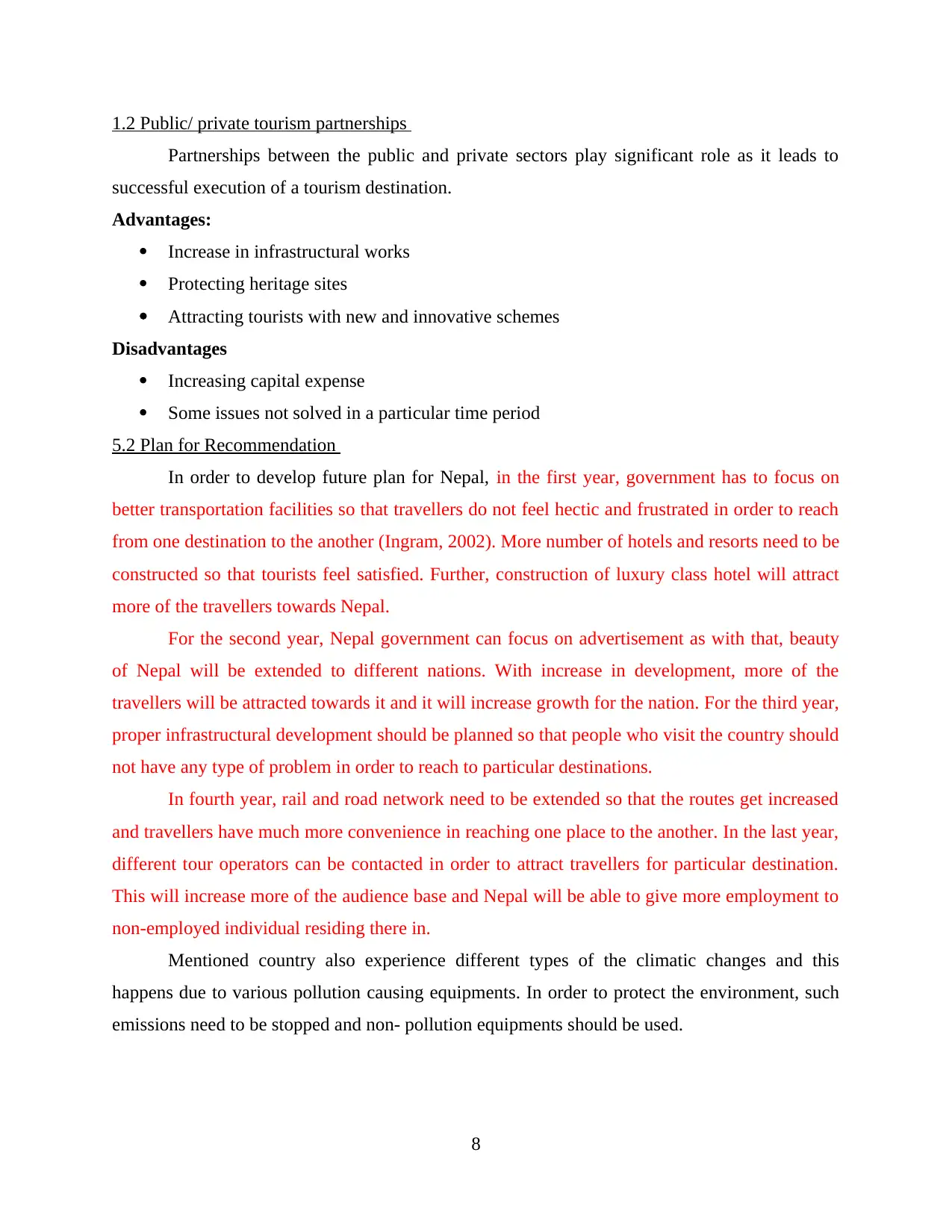
1.2 Public/ private tourism partnerships
Partnerships between the public and private sectors play significant role as it leads to
successful execution of a tourism destination.
Advantages:
Increase in infrastructural works
Protecting heritage sites
Attracting tourists with new and innovative schemes
Disadvantages
Increasing capital expense
Some issues not solved in a particular time period
5.2 Plan for Recommendation
In order to develop future plan for Nepal, in the first year, government has to focus on
better transportation facilities so that travellers do not feel hectic and frustrated in order to reach
from one destination to the another (Ingram, 2002). More number of hotels and resorts need to be
constructed so that tourists feel satisfied. Further, construction of luxury class hotel will attract
more of the travellers towards Nepal.
For the second year, Nepal government can focus on advertisement as with that, beauty
of Nepal will be extended to different nations. With increase in development, more of the
travellers will be attracted towards it and it will increase growth for the nation. For the third year,
proper infrastructural development should be planned so that people who visit the country should
not have any type of problem in order to reach to particular destinations.
In fourth year, rail and road network need to be extended so that the routes get increased
and travellers have much more convenience in reaching one place to the another. In the last year,
different tour operators can be contacted in order to attract travellers for particular destination.
This will increase more of the audience base and Nepal will be able to give more employment to
non-employed individual residing there in.
Mentioned country also experience different types of the climatic changes and this
happens due to various pollution causing equipments. In order to protect the environment, such
emissions need to be stopped and non- pollution equipments should be used.
8
Partnerships between the public and private sectors play significant role as it leads to
successful execution of a tourism destination.
Advantages:
Increase in infrastructural works
Protecting heritage sites
Attracting tourists with new and innovative schemes
Disadvantages
Increasing capital expense
Some issues not solved in a particular time period
5.2 Plan for Recommendation
In order to develop future plan for Nepal, in the first year, government has to focus on
better transportation facilities so that travellers do not feel hectic and frustrated in order to reach
from one destination to the another (Ingram, 2002). More number of hotels and resorts need to be
constructed so that tourists feel satisfied. Further, construction of luxury class hotel will attract
more of the travellers towards Nepal.
For the second year, Nepal government can focus on advertisement as with that, beauty
of Nepal will be extended to different nations. With increase in development, more of the
travellers will be attracted towards it and it will increase growth for the nation. For the third year,
proper infrastructural development should be planned so that people who visit the country should
not have any type of problem in order to reach to particular destinations.
In fourth year, rail and road network need to be extended so that the routes get increased
and travellers have much more convenience in reaching one place to the another. In the last year,
different tour operators can be contacted in order to attract travellers for particular destination.
This will increase more of the audience base and Nepal will be able to give more employment to
non-employed individual residing there in.
Mentioned country also experience different types of the climatic changes and this
happens due to various pollution causing equipments. In order to protect the environment, such
emissions need to be stopped and non- pollution equipments should be used.
8

CONCLUSION
From the above report, it is clearly identified that the mentioned country is focusing on
increasing more number of visitors towards it in order to foster the economic growth and revenue
within the country. Further, Nepal is making its foot towards the sustainable development and
local bodies along with some private firms by making effective contribution to enhance new
development and to protect the existing ones.
9
From the above report, it is clearly identified that the mentioned country is focusing on
increasing more number of visitors towards it in order to foster the economic growth and revenue
within the country. Further, Nepal is making its foot towards the sustainable development and
local bodies along with some private firms by making effective contribution to enhance new
development and to protect the existing ones.
9
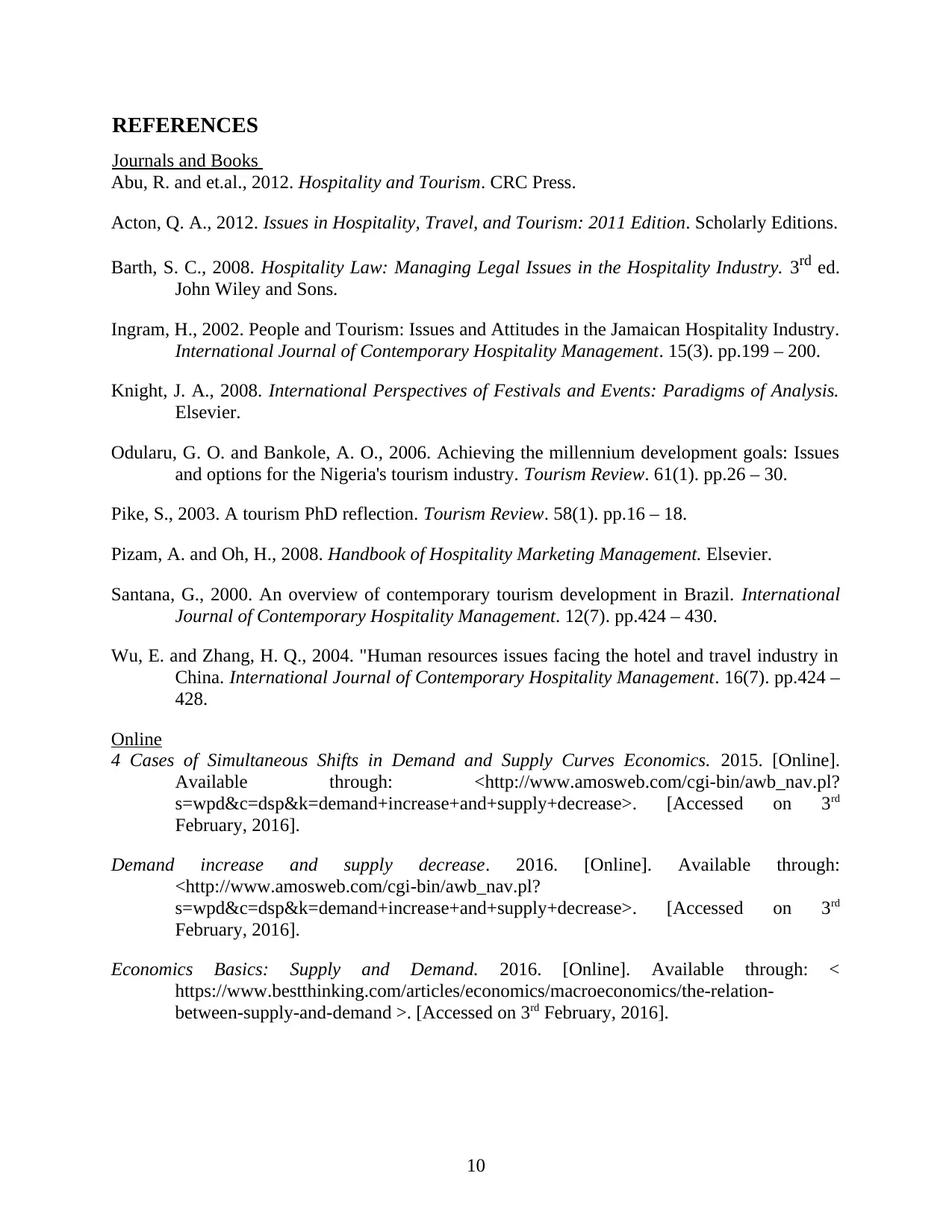
REFERENCES
Journals and Books
Abu, R. and et.al., 2012. Hospitality and Tourism. CRC Press.
Acton, Q. A., 2012. Issues in Hospitality, Travel, and Tourism: 2011 Edition. Scholarly Editions.
Barth, S. C., 2008. Hospitality Law: Managing Legal Issues in the Hospitality Industry. 3rd ed.
John Wiley and Sons.
Ingram, H., 2002. People and Tourism: Issues and Attitudes in the Jamaican Hospitality Industry.
International Journal of Contemporary Hospitality Management. 15(3). pp.199 – 200.
Knight, J. A., 2008. International Perspectives of Festivals and Events: Paradigms of Analysis.
Elsevier.
Odularu, G. O. and Bankole, A. O., 2006. Achieving the millennium development goals: Issues
and options for the Nigeria's tourism industry. Tourism Review. 61(1). pp.26 – 30.
Pike, S., 2003. A tourism PhD reflection. Tourism Review. 58(1). pp.16 – 18.
Pizam, A. and Oh, H., 2008. Handbook of Hospitality Marketing Management. Elsevier.
Santana, G., 2000. An overview of contemporary tourism development in Brazil. International
Journal of Contemporary Hospitality Management. 12(7). pp.424 – 430.
Wu, E. and Zhang, H. Q., 2004. "Human resources issues facing the hotel and travel industry in
China. International Journal of Contemporary Hospitality Management. 16(7). pp.424 –
428.
Online
4 Cases of Simultaneous Shifts in Demand and Supply Curves Economics. 2015. [Online].
Available through: <http://www.amosweb.com/cgi-bin/awb_nav.pl?
s=wpd&c=dsp&k=demand+increase+and+supply+decrease>. [Accessed on 3rd
February, 2016].
Demand increase and supply decrease. 2016. [Online]. Available through:
<http://www.amosweb.com/cgi-bin/awb_nav.pl?
s=wpd&c=dsp&k=demand+increase+and+supply+decrease>. [Accessed on 3rd
February, 2016].
Economics Basics: Supply and Demand. 2016. [Online]. Available through: <
https://www.bestthinking.com/articles/economics/macroeconomics/the-relation-
between-supply-and-demand >. [Accessed on 3rd February, 2016].
10
Journals and Books
Abu, R. and et.al., 2012. Hospitality and Tourism. CRC Press.
Acton, Q. A., 2012. Issues in Hospitality, Travel, and Tourism: 2011 Edition. Scholarly Editions.
Barth, S. C., 2008. Hospitality Law: Managing Legal Issues in the Hospitality Industry. 3rd ed.
John Wiley and Sons.
Ingram, H., 2002. People and Tourism: Issues and Attitudes in the Jamaican Hospitality Industry.
International Journal of Contemporary Hospitality Management. 15(3). pp.199 – 200.
Knight, J. A., 2008. International Perspectives of Festivals and Events: Paradigms of Analysis.
Elsevier.
Odularu, G. O. and Bankole, A. O., 2006. Achieving the millennium development goals: Issues
and options for the Nigeria's tourism industry. Tourism Review. 61(1). pp.26 – 30.
Pike, S., 2003. A tourism PhD reflection. Tourism Review. 58(1). pp.16 – 18.
Pizam, A. and Oh, H., 2008. Handbook of Hospitality Marketing Management. Elsevier.
Santana, G., 2000. An overview of contemporary tourism development in Brazil. International
Journal of Contemporary Hospitality Management. 12(7). pp.424 – 430.
Wu, E. and Zhang, H. Q., 2004. "Human resources issues facing the hotel and travel industry in
China. International Journal of Contemporary Hospitality Management. 16(7). pp.424 –
428.
Online
4 Cases of Simultaneous Shifts in Demand and Supply Curves Economics. 2015. [Online].
Available through: <http://www.amosweb.com/cgi-bin/awb_nav.pl?
s=wpd&c=dsp&k=demand+increase+and+supply+decrease>. [Accessed on 3rd
February, 2016].
Demand increase and supply decrease. 2016. [Online]. Available through:
<http://www.amosweb.com/cgi-bin/awb_nav.pl?
s=wpd&c=dsp&k=demand+increase+and+supply+decrease>. [Accessed on 3rd
February, 2016].
Economics Basics: Supply and Demand. 2016. [Online]. Available through: <
https://www.bestthinking.com/articles/economics/macroeconomics/the-relation-
between-supply-and-demand >. [Accessed on 3rd February, 2016].
10
1 out of 13
Related Documents
Your All-in-One AI-Powered Toolkit for Academic Success.
+13062052269
info@desklib.com
Available 24*7 on WhatsApp / Email
![[object Object]](/_next/static/media/star-bottom.7253800d.svg)
Unlock your academic potential
© 2024 | Zucol Services PVT LTD | All rights reserved.





